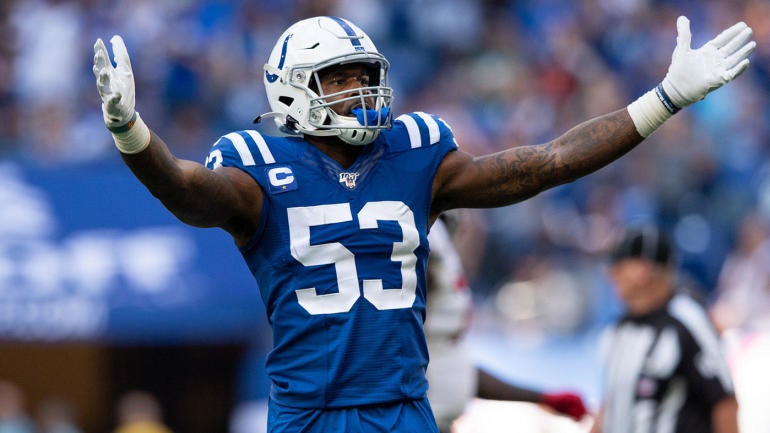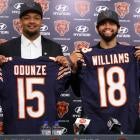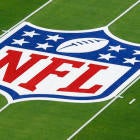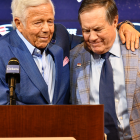
Multiple positional markets (center, offensive guard, safety, etc.) have established new salary benchmarks this offseason despite the salary cap dropping $15.7 million from $198.2 million in 2020 to $182.5 million this year. Several positions -- including cornerback edge rusher, offensive tackle, quarterback, tight end and wide receiver -- underwent a major reset in 2020.
The off-ball linebacker market hasn't been one of those positions to reach new heights yet. That should change soon because 2018 draftees Darius Leonard and Fred Warner are in contract years. Both are scheduled to make $3.384 million this year.
Leonard and the Colts have been engaging in discussions about a new contract. According to The Athletic's Zac Keefer, the Colts are making headway on contract extensions for Leonard and right tackle Braden Smith. Colts owner Jim Irsay told Keefer last week that the goal was to have both deals done before the regular season starts in September.
Leonard has been magnificent in his three NFL seasons. He was named NFL Defensive Rookie of the Year in 2018 after leading the league with 163 tackles. Leonard also had seven sacks, which is an impressive total for an off-ball linebacker. He was immune from a sophomore slump. Leonard led NFL linebackers with five interceptions in 2019. He has earned All-Pro honors in each of his seasons.
Leonard is reportedly ahead of Warner in the timing of negotiations but not necessarily on the football field. Warner started emerging in 2019 when he was named November's NFC Defensive Player of the Month. He had a true breakout season in 2020. Warner earned his first Pro Bowl berth and was named first-team All-Pro last year. Jets head coach Robert Saleh called Warner the best middle linebacker by far last season when coaching him as the 49ers defensive coordinator. Pro Football Focus just named Warner the NFL's best player under the age of 25.
Current NFL off-ball linebacker salary standards
Any deal Leonard or Warner signs could set new standards in most major contract metrics for off-ball linebackers. The financial benchmarks of key contract metrics for veteran players that should be relevant to Leonard and Warner's contract discussions are listed below.
Average yearly salary: $18 million (Bobby Wagner - Seahawks)
Overall contract guarantees: $51 million (C.J. Mosley - Jets)
Fully guaranteed at signing: $43 million (Mosley)
Signing bonus: $15 million (Wagner)
Three-year cash flow: $51 million (Mosley)
First three new years: $54 million (Wagner)
The off-ball linebacker market took a dramatic jump in 2019. Kwon Alexander briefly became the highest paid with the four-year, $54 million deal containing $27.5 million of guarantees he received from the 49ers in free agency. C.J. Mosley quickly took the compensation to a different level. He signed a five-year, $85 million contract with the Jets as an unrestricted free agent. Another shift in this market occurred when six-time All-Pro Bobby Wagner received a three-year, $54 million extension with $40.25 million in guarantees from the Seahawks at the start of training camp.
No off-ball linebacker has approached Wagner's deal since he signed. Texans inside linebacker Zach Cunningham has come the closest. He signed a four-year, $58 million extension averaging $14.5 million per year with $33,574,783 of guarantees last year. Jerome Baker is the most recent data point in the marketplace. The three-year, $37.5 million extension averaging $12.5 million per year with $28.41 million of guarantees he just received from the Dolphins won't be relevant to Leonard and Warner's negotiations.
How contracts are valued
Professionals within the industry (agents and team negotiators) typically value deals by new money, which is the amount of compensation in a contract excluding what a player was scheduled to make before receiving a new deal. For example, Wagner had one year remaining on his existing contract with an $11.5 million salary for 2019 prior to his signing. Although Wagner signed a four-year contract for $65.5 million, his deal is looked at as a three-year, $54 million extension averaging $18 million per year among industry professionals. His existing contract year for $11.5 million is subtracted from the $65.5 million, four-year total to arrive at this number.
Every deal I did in my numerous years as an agent was focused on how much new money and how many new contract years when a player had contract years remaining. Negotiations weren't as if deals were being ripped up like a player wasn't already under contract.
Former longtime Eagles president and Browns CEO Joe Banner, who was the smartest person I dealt with from a team while an agent, has previously reinforced this point.
All contracts are valued by averaging the New Years. If a team doesn’t do that they are actually being penalized for signing a player early, which makes no sense. Never had an agent even push back on this. It’s obviously the fair way to do it.
— Joe Banner (@JoeBanner13) September 8, 2020
Compensation in the first three new years is the amount of money in a contract exclusive of what a player was scheduled to make before receiving a new deal, just like with new money when determining average yearly salary. The cash flow analysis looks at the compensation in its totality. The focus is on the amount of money received in the first three years of a contract regardless of whether it's considered as new money. Both metrics have the same dollar amount when a player signs a new contract as a free agent or when his contract is set to expire.
Overall contract guarantees can be misleading. A complete picture of a contract's true security isn't given by this metric. The amount of money fully guaranteed at signing and what will become fully guaranteed early in the contract are the best and most accurate measures of security.
The franchise tag factor
Ordinarily, a franchise tag wouldn't be a consideration. An off-ball linebacker hasn't been designated as a franchise player since the Jets tagged David Harris in 2011. The designation is usually reserved for pass-rushing 3-4 outside linebackers who would be defensive ends in a 4-3 scheme. Since elite pass rushers are paid a premium, the linebacker number hasn't reflected the off-ball linebacker market.
Should either Leonard or Warner's rookie contracts expire, it wouldn't be a surprise for the Colts or 49ers to use the franchise tag to keep them off the open market because of their importance to their respective teams. The Colts need to get Leonard or Smith signed to a new deal since teams can use the designation on only one player per year. Warner is San Francisco's only realistic franchise tag candidate for 2022.
The NFL and NFLPA recently agreed to a salary cap ceiling of $208.2 million for 2022. Next year's linebacker franchise tag should be 9.024% of the 2022 salary cap. At the $208.2 million ceiling, the 2022 linebacker number projects to be $18.788 million. A second franchise tag in 2023 at a collective bargaining agreement-mandated 20% increase would be $22,545,600. Since it is customary for agents to look at the average of receiving two franchise tags when the designation is a distinct possibility for a client, there would be justification for seeking over $20 million per year in these cases.
Regardless, Wagner shouldn't remain the salary standard for off-ball linebackers in average yearly salary once Leonard and Warner sign new deals. Eclipsing Mosley's guaranteed money benchmarks may be a more difficult proposition.
Other considerations
Wagner's $18 million per year is 5.88% more than Mosley's deal. A similar increase by the player to sign first, presumably Leonard since he began negotiations before Warner, would be in the $19 million-per-year neighborhood.
The odds are stacked against Leonard becoming the highest-paid defensive player on the Colts. It's currently defensive tackle DeForest Buckner. He signed a four-year, $84 million extension averaging $21 million per year with $56.378 million in guarantees after the Colts acquired him from the 49ers in a trade last offseason. $39.378 million was fully guaranteed at signing.
The Colts currently have $13,245,514 of cap space, according to NFLPA data. A deviation from the preferred "pay as you go" contract structure utilized with practically all of Indianapolis' veteran signings will likely be necessary to sign both Leonard and Smith to extensions this year.
A player's cash and salary cap numbers are the same in each contract year with the "pay as you go" structure because there isn't a signing bonus that's prorated over the life of the contract (for a maximum of five years).
Salary guarantees are given instead under the "pay as you go" model. Deals with this structure have higher cap numbers initially because of the absence of a signing bonus. The first contract year usually consists of a fully guaranteed base salary and a roster bonus due a few days after signing. The second year in the most lucrative "pay as you go" contracts has a fully guaranteed base and roster bonus due during the first couple of days of the league year that became fully guaranteed within a few days of initially signing. There may also be conditional guarantees in the third contract year.
A big benefit to "pay as you go" contracts is that there aren't any residual salary cap charges or dead money when a player is released during the latter years of the deal once the guarantees have expired, provided the contract hasn't been restructured to create cap room by converting salary into signing bonus.
The "pay as you go" concept isn't embraced by most NFL teams. Besides the Colts, the Buccaneers and Raiders have been the biggest proponents of this structure. The Buccaneers largely abandoned the "pay as you go" model when re-signing players this offseason to keep the team intact in their quest to repeat as Super Bowl champions.
The Colts have already made one exception this offseason. Offensive tackle Eric Fisher's one-year deal contains a $4 million signing bonus. A 2022 contract year automatically voiding next March on the 23rd day prior to the first day of the 2022 league year was added so his signing bonus could be prorated on the salary cap at $2 million in both 2021 and 2022.
Warner should be the highest-paid defensive player on the 49ers. Defensive end Arik Armstead is the benchmark in San Francisco at $17 million per year with fellow lineman Dee Ford taking a pay cut.
Both players should look at Wagner's veteran contracts to try to maximize career earnings. With the salary cap set to explode in the coming years thanks to new media rights deals reportedly worth $13 billion over 11 years and an influx of gambling revenue, the idea should be to get as many "bites of the apples" as possible. Wagner's first extension in the final year of his rookie deal was four years. His current extension signed in 2019 at 29 added three new years.
2022 will be Wagner's contract year. It's conceivable he could sign another lucrative extension next offseason as a 32-year-old since he has been the model of consistency. Wagner and Rams interior defensive lineman Aaron Donald -- a three-time NFL Defensive Player of Year -- are the only players to be named first-team All-Pro by the Associated Press in each of the previous five seasons (2016 through 2020). The future Hall of Famer was recently ranked by PFF as the NFL's top linebacker heading into the 2021 season.
Signing an extension for more than four new years would potentially jeopardize the ability to optimize career compensation. This is particularly the case with Leonard. He will be 26 in July. Warner won't turn 25 until the middle of the upcoming season.
Final thoughts
As an agent, I accepted that high-end contracts were made to be surpassed. This means whichever player signs last, Leonard or Warner, stands a good chance of being the highest-paid off-ball linebacker. Some agents and players can be sensitive to a market setting contract quickly being topped. This sensitivity can become such a factor in negotiations where reaching an agreement becomes more difficult. It certainly can't be dismissed with this situation.





















